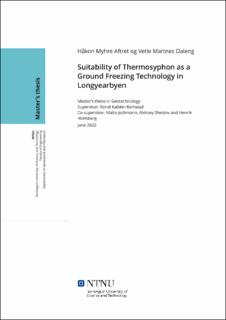| dc.contributor.advisor | Ramstad, Randi Kalskin | |
| dc.contributor.advisor | Jochmann, Malte | |
| dc.contributor.advisor | Shestov, Aleksey | |
| dc.contributor.advisor | Holmberg, Henrik | |
| dc.contributor.author | Daleng, Vetle Martnes | |
| dc.contributor.author | Aftret, Håkon Myhre | |
| dc.date.accessioned | 2022-09-20T17:22:30Z | |
| dc.date.available | 2022-09-20T17:22:30Z | |
| dc.date.issued | 2022 | |
| dc.identifier | no.ntnu:inspera:114862279:21621593 | |
| dc.identifier.uri | https://hdl.handle.net/11250/3019953 | |
| dc.description.abstract | Nedkjøling av grunnen er i mange tilfeller nødvendig ved bygging av infrastruktur i arktiske områder for å unngå tining av permafrost. Tining av løsmasser og berg reduserer materialets trykkfasthet, som igjen kan gi setninger og skader på konstruksjoner. I avsidesliggende områder som Longyearbyen er energi kostbart og har høye CO2-utslipp. Det er derfor viktig å sikre at energien utnyttes så effektivt som mulig. Termosifonger er tofasede varmevekslere som kan utnytte kald luft til å kjøle ned bakken uten behov for ekstra energi. Målet med denne oppgaven er å vurdere termosifongers egnethet for nedkjøling av grunnen i Longyearbyen. Det er flere potensielle bruksområder, inkludert kjøling for vindmøllefundamenter, bygninger, geotermiske brønner og annen infrastruktur. Egnethet for kjøling ved bruk av termosifong i dagens og fremtidig klima er vurdert ut fra beregninger i programvaren COMSOL. For fremtidig klima er det vurdert to CO2-utslippsscenarier, RCP45 og RCP85. RCP45 er et middels utslippsscenario med moderat økning i lufttemperatur, RCP85 er scenarioet med størst utslipp og høyest temperaturøkning. Den numeriske modellen inkluderer en simulering med et bygningsfundament på permafrost.
Modellering viser reduserte temperaturer i grunnen ved installasjon av termosifonger. Effekten reduseres for høyere lufttemperaturer med fremtidige klimaendringer. Høye utslipp, RCP85, vil føre til omfattende tining av permafrost, og termosifonger blir ikke sett på som egnet for slike temperaturer. For dagens klima- og moderate utslipp, RCP45, kan termosifonger gi passiv kjøling og effekten er tilstede gjennom vinteren. Om sommeren vil ikke termosifonger gi kjøling på grunn av høye lufttemperaturer. På grunn av dette anses en hybrid termosifongløsning, med mulighet for å for å gi aktiv kjøling, i tillegg til passiv kjøling, som en gunstigere løsning. Denne studien antyder at termosifonger har potensial til å bli brukt for nedkjøling av grunnen i Longyearbyen. | |
| dc.description.abstract | Ground cooling is necessary in many cases when constructing infrastructure in Arctic areas to avoid permafrost thawing, settlements, and damage to constructions. Thawing of soil and rock decreases the compressive strength of the material. In remote areas such as Longyearbyen energy is expensive and comes with high CO2 emissions. For this reason, it is essential to ensure that energy is not wasted and utilized as efficiently as possible. Thermosyphons are two-phased heat exchangers that utilize cold air to cool the ground without the need for additional energy. The goal of this thesis is to review the suitability of thermosyphons as a ground freezing technology in Longyearbyen. There are several potential applications including ground freezing for windmill foundations, buildings, geothermal wells and other infrastructure. Establishing a numerical model in the commercial software, COMSOL, the study evaluates thermosyphon cooling for today's climate and future climate, for two CO2 emissions scenarios, RCP45 and RCP85. RCP45 is a middle emission scenario with a moderate increase in air temperature, and RCP85 is the worst-case emission scenario with the highest temperature increase. The numerical model includes a building foundation case.
Results from modeling shows lower ground temperatures with thermosyphons in operation. The effect is reduced for higher air temperatures with future climate change. High emissions, RCP85, will lead to extensive thawing of permafrost, and thermosyphons are will not be suitable for such temperatures. For today's climate and mid-range emissions, RCP45, thermosyphons can provide cooling passively and the effect is present during winter. During summer thermosyphons can not provide cooling due to warm air. Therefore, a hybrid thermosyphon solution, with the option to provide active cooling, in addition to passive cooling, is considered a favorable solution. This study suggests that thermosyphons have the potential to be used for ground freezing in Longyearbyen. | |
| dc.language | eng | |
| dc.publisher | NTNU | |
| dc.title | Suitability of Thermosyphon as a Ground Freezing Technology in Longyearbyen | |
| dc.type | Master thesis | |
